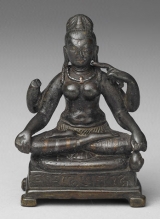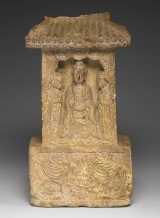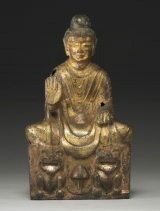|
Tags: art | Buddhism | exhibition | Peng Kai-dong
Mr. Peng Kai-dong led an extraordinary life.
Born in Hsin-chu, Taiwan, in 1912, he played snooker actively in his early years before moving to Japan to make a living at the age of 15. He then traveled between Taiwan and Japan frequently before he eventually settled down in Japan. Although he did not have a distinguished education, his tenacity, determination to succeed, original vision, and excellent social networking made him one of the most successful businessmen in Japan. Eventually amassing a vast business syndicate, it covered a wide range of industries such as retailing, jewellery, restaurants, galleries and property management. In fact, he was once rated as the thirteenth richest person in Japan. He was therefore able to build up a great collection of Buddhist art, using his successful business consortium as a financial source.
At the age of 33, after the Second World War, a great number of antiquities were changing hands in the art market because of post-war socio-political instability. Mr. Peng, strongly attracted to the beauty of these antiques, started to collect them at that time. He acquired all sorts of objects in the beginning, but he then limited his collection solely to Buddhist images. Mr. Peng collected Buddhist artifacts with great passion. On the one hand, he traveled all over the world to visit exhibitions, museums, and galleries, establishing connections with distinguished collectors as well as sharing experience and knowledge with his Japanese colleagues. On the other hand, he acquired extremely rare and valuable Buddhist artifacts via well-known international auction houses. Consequently, Mr. Peng's collection of religious art became widely regarded for its world-class variety and quality of images from a wide range of places of origin.
Mr. Peng also developed a long and deep relationship with the National Palace Museum through their shared interest in Buddhist art.
Out of affection for his homeland in his later years, in 1987 Mr. Peng lent his excellent collection of gilt bronze Buddhist sculptures to the National Palace Museum for a special exhibition, and nine years later he sold 32 of them to the Museum. In 2004, he donated 358 bronze sculptures and objects of his collection to the Museum, and a special exhibition,"The Casting of Religion," was based on his donation and organized in the same year. Mr. Peng sadly passed away in 2006, and in his will he again donated 48 pieces to the National Palace Museum.
Though the amount of this bequest is not great, nor the size of the items large, these 48 religious bronzes ought to be justifiably treated as a classic reflection upon Mr. Peng's lifelong devotion to Buddhist art. The present exhibition aims to share the sublime elegance of these Buddhist images with members of the public to commemorate the lasting contribution that Mr. Peng has made in promoting the significance of Buddhist art. Like Mr. Peng Kai-dong himself, "Religious images of awe and inspiration, their dignifying manner shall transcend countless generations to come!"
| Western year |
Years of Age |
Events |
| 1912 |
0 year |
He was born on October, 5 in Hsin-chu, Taiwan. |
| 1913 |
3 months |
In January, his father went missing after an accident at sea. |
| 1915, 16 |
3 years /4 years |
His mother remarried. The incident has a long term effect on his psychological development. |
| 1919 |
7 years |
He dropped out from school after one and half years education.
He then worked at a snooker club and decided to go to Tokyo to become a professional player there. |
| 1927 |
15 years |
A Japanese Dentist took him to Tokyo, Japan. |
| 1928 |
156 years |
He worked at a snooker club through Mr. Akita's introduction. |
| 1931 |
19 years |
He was married with Ms. Lee Ai-yu. He returned to Taipei because of his wife's illness and established a snooker shop selling snooker materials. |
| 1934 |
22 years |
His first wife, Ms. Lee Ai-yu died. |
| 1938 |
26 years |
He was remarried with Ms. Nagashima. He renamed himself as Nita Munachi |
| 1939 |
27 years |
He returned to Taiwan. He taught officers in The Taiwanese Governor's Office playing snooker, as well as set up a business supplying goods for Japanese Naval Forces. |
| 1941 |
29 years |
He established a company, Nita Enterprise Limited, for shipping unapproved raw materials to Japan. |
| 1945 |
33 years |
After the Second World War, he was not allowed to return to Taiwan as he was classified as Class B war criminal.
He opened a jewellery antique shop in Ginza, Tokyo, and established good connections with his fellow colleagues. |
| 1946-50 |
34 years – 38 years |
He closed down his antique business, and started running restaurants. |
| 1950 |
38 years |
He first acquisition of Buddhist art.
He acquired a standing Buddha sculpture, Sui Dynasty, and a piece of Dunhuang Buddhist painting (designated as Important Cultural Property). |
| 1952, 53 |
40 years /41 years |
He was not allowed to go abroad for three years due to violation of financial regulations.
He decided to limit his collection solely on Buddhist images after this event. |
| 1955 |
43 years |
He bought a plot of land to construct a building for art exhibition. |
| 1956 |
44 years |
He acquired a piece of Degas' big painting and a piece of Renoir's painting,'A girl with a hat', in Paris. |
| 1960 |
48 years |
He acquired a piece of gilt bronze, Shakyamuni , Tai-ho 1st year, Northern Wei dynasty. |
| 1964 |
52 years |
He opened up international night clubs, coffee shops and Nita Gallery for the event of Tokyo Olympic 1964. |
| 1965 |
53 years |
He bought a standing Bodhisattva gilt bronze. In its inscription, it is said that the sculpture was donated by one Mr. Peng in the second year of Ta-yeh era of Sui Dynasty. The Sculpture has since been worshiped in the Peng family ancestry altar. |
| 1970 |
58 years |
He exchanged a piece of Korin hanging scroll and a piece of stone Buddhist sculpture with the Nezu Museum, Japan for three pieces of gilt bronze seated Buddha from Ming Dynasty. |
| 1970 |
58 years |
He acquired a wooden standing bodhisattva sculpture from Heian Period, Japan (designated as Important Cultural Property) |
| 1971 |
59 years |
He sold out business of night club, coffee shop and Nita Gallery.
He started up his property business and acquired properties in Harajuku and Ginza area. |
| 1980 |
68 years |
He acquired a seated Buddha Shakyamuni, Tai-ho era, Northern Wei dynasty after the second world war. |
| 1981 |
69 years |
He was rated the thirteen richest person in Japan by The Nikkei Newspaper. |
| 1987 |
75 years |
In October, a special exhibition of gilt bronze sculptures based on Mr. Peng's collection was launched in the National Palace Museum. |
| 1992 |
80 years |
He gave six major parts of his art collection to his three sons. |
| 1996 |
84 years |
He sold 32 pieces of gilt bronzes to the National Palace Museum. |
| 1997 |
85 years |
He sold two big Japanese wooden sculptures and one Buddhist painting to the Agency for Cultural Affairs, Japan which are displayed in the newly built Heisei Hall (Heiseikan), The Tokyo National Museum. |
| 1998 |
86 years |
Nita Groups and MSIKARU Company in Osaka were merged. |
| 2003 |
91 years |
He donated seven pieces of gilt bronze sculptures to the Metropolitan Museum, New York, USA. |
| 2004 |
93 years |
He donated 358 pieces of gilt bronze objects to the National Palace Museum. A special exhibition,"The Casting of Religion," was based on his donation and organized in the same year.
He also donated a piece of gilt bronze sculpture, Northern Wei dynasty and painting of Tun-huang, Tang dynasty (designated as Important Cultural Property, Japan) to Taipei Economic and Cultural Representative Office in Japan. |
| 2006 |
95 years |
In September, he donated a piece of four-sided stele to the National Palace Museum.
He died on Nov 24. In his will, he again donated 48 pieces of gilt bronzes to the National Palace Museum. |
| 2008 |
|
An exhibition 'Enduring Splendor – A special exhibition of Mr. Peng Kai-dong's bequest' was launched in honor of Mr. Peng lifelong contribution to Buddhist Art. |

|
Four-armed Bhrikuti
East India, Pala Dynasty, 9th c.
Bronze inlaid with silver and copper
H: 7.3cm, W: 4.6cm
|
Bhrkuti, one of the female companions of Avalokiteshvara, is envisioned as the female hypostases of Avalokiteshvara's wisdom. Her four arms hold a stem of willow, a water vase of purity, and a string of recitation beads (now lost), also making the mudra (hand gesture) of bestowal. Her third eye and lips have silver and pure copper inlay, respectively, and the skirt has an overlay of both metals.

|
Seated Śakyamuni
Sri Lanka, Anuradhapura period, 9th c.
Gilt bronze, H: 11cm, W: 8.4cm
|
The Buddha is seated in the virasana posture, right leg over the left, and makes the mudra of meditation; his eyes are half-closed as if in deep contemplation. Upon the auspicious protuberance on top of the head is the flame of wisdom encrusted with a gem, presumably a ruby. The august Buddha has broad shoulders, a thin and pinched waist, and smooth robes worn with the right shoulder bare. This is a fine example of classic ninth-century Sri Lankan bronze sculpture.

|
Four-sided Stele with a roof-shaped top
China, Western Wei dynasty, dated 548
Yellow limestone, H: 34.7cm, W: 18.7cm
|
The work is shaped with four niches in which are displayed four Buddhist images. The stele is covered with a rooftop which represents the palace in the heavens. There are the seated Buddha and Bodhisattva seated in the front and the back of the stele respectively. On the side of the stele is a standing attending bodhisattva. This is an artistic characteristic of the Western Wei dynasty. The impression of both the Buddha and bodhisattva images and monks, donors, and lions carved outside the niche are solemnly respectful and genuine. The execution is calmingly forceful and accurate.

|
Seated Buddha
China, Northern Wei dynasty, 5th c.
Gilt bronze, H: 21.4cm, W: 12.4cm
|
The Buddha Shakyamuni sits in meditation on a low lion throne, lifting his right hand in the abhaya mudra while holding his robe in the left. The Buddha Shakyamuni is draped with a robe indicated with a regular system of parallel curves, a typical early style in Chinese Buddhist images. Both the impression of the Buddha and the lion are simple yet charming.
View website
|
















